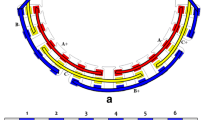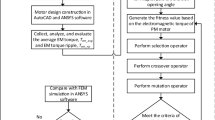Abstract
Lightweight electric motor topologies used in electric transport applications require high-power density structures. Selection of suitable core material with appropriate physical geometry is important at design stage to reduce the core losses and the weight of the motor. This paper presents a novel hybrid metaheuristic optimization technique termed as Aquila-Grasshopper-Optimization (AGO), inspired by the hunting behavior of Aquila and swarming behavior of grasshoppers in search of the food source. This technique merges the merits of both Aquila optimizer (AO) and Grasshopper optimization algorithm (GOA) to create a balance between exploration and exploitation stages. By introducing the concept of normalization of the distances between the solutions (swarms) of the optimization problem at both narrowed and expanded exploration and exploitation stages of AO, the population is searched thoroughly to avoid the possibility of converging to any local optimum and to increase the convergence rate to reach the global optima. The performance of the proposed technique is first tested for various benchmark functions and thereafter implemented to the real-world problem to optimize the motor geometry of Surface Inset Permanent Magnet Synchronous Motor (SI-PMSM) to reduce the overall core losses. Two different core materials are employed in the core of the motor to study the influence of core material on the performance of the motor. In addition, the study is expanded by providing suitable trench cuts in motor core so that weight of the motor can be reduced substantially for lightweight motor applications. It is established that the variation in properties of core material can increase the power density and AGO technique can minimize core losses to obtain optimized motor core geometry thereby improving the overall electromagnetic performance of the motor.













Similar content being viewed by others
References
Baojun, Q.; Qingxin, Y.; Li, Y.; Miguel Angel, S.; Ma, S.: Li Z (2020) A novel surface inset permanent magnet synchronous motor for electric vehicles. Symmetry, MDPI 12, 179 (2020)
Kolano, R.; Burian, A.K.; Krykowski, K.; Hreczka, M.; Polak, M.: Amorphous soft magnetic core for stator of the high speed PMBLDC motor with half open slots. IEEE Trans. Magn. 52(006), 2016 (2016)
Zhu, X.; Cheng, M.; Xiao, F.; Sun, Y.: Comparison of doubly salient permanent magnet machines with E-shaped and π-shaped stator iron core segments. In: IEEE International Magnetics Conference (2015)
Feng, Y.; Zhang, C.: Core loss analysis of interior permanent magnet synchronous machines under SVPWM excitation with considering saturation. Energies 10, 005–006 (2017)
Koo, M.-M.; Kim, J.-M.; Kim, C.-W.; Ahn, J.-H.; Hong, K.; Jang-Young, C.: Core loss analysis of permanent magnet synchronous generator with slotless Stator. IEEE Trans. Appl. Supercond. 28(3), 1–4 (2018)
Guo, Y.; Jianguo, Z.; Lu, H.; Lin, Z.; Li, Y.: Core loss calculation for soft magnetic composite electrical machines. IEEE Trans. Magn. 48(11), 3112–3114 (2012)
Yao, A.; Odawara, S.; Sugimoto, T.; Fujisaki, K.: Core loss properties of a motor with Nano crystalline Rotor and Stator cores under inverter excitation. IEEE Trans. Magn. 54(11), 1–5 (2018)
Okamoto, S.; Denis, N.; Kato, Y.; Ieki, M.; Fujisaki, K.: Core loss reduction of an interior PMSM using amorphous stator core. IEEE Trans. Ind. Appl. 52(3), 2261–2266 (2016)
Mohamed, E.E.: Electromagnetic performance of partitioned stator PM machines with dual C-core/E-core topologies. In: International Middle East Power System Conference (MEPCON) (2017)
Huang, Y.; Dong, J.; Zhu, J.; Guo, Y.: Core loss modeling for permanent magnet motor based on flux variation locus and finite element method. IEEE Trans. Magn. 48, 1023–1026 (2012)
Ibrahim, M.; Pillay, P.: Advanced testing and modeling of magnetic materials including a new method of core loss separation for electrical machines. IEEE Trans. Ind. Appl. 48, 1507–1514 (2012)
Gordon, R.S.; Liu, X.: Core losses in Permanent magnet motors. IEEE Trans. Magn. 26, 1653–1655 (1990)
Russell, E.; James, K.: A New Optimizer using particle swarm theory. In: Sixth International Symposium on Micro Machines and Human Science, IEEE, pp. 39–43 (1995)
Marco, D.; Vittorio, M.; Alberto, C.: Ant system: optimization by a colony of cooperating agents. IEEE Trans. Syst. Man Cybern. 26, 29–40 (1996)
Dervis, K.; Bahriye, B.: A powerful and efficient algorithm for Numerical Function optimization : artificial bee colony (ABC) algorithm. J. Global Optim. 39, 59–471 (2007)
John, J.: Genetic algorithms. Sci. Am. 267, 66–73 (1992)
Esmat, R.; Hossein, N.; Saeid, S.: GSA: a gravitational search algorithm. Inf. Sci. 179, 2232–2248 (2009)
Seyedali, M.; Seyed, M.M.; Abdolreza, H.: Multi-verse optimizer: a nature inspired algorithm for global optimization. Neural Comput. Appl. 27, 495–513 (2015)
Meeta, K.; Anand, J.H.; Suresh, C.: Socio evolution & learning optimization algorithm: a socio-inspired optimization methodology. Futur. Gener. Comput. Syst. 81, 252–272 (2017)
Laith, A.; Daibat, A.; Mirjalili, S.; Mohamed, A.; Amir, H.: The arithmetic optimization algorithm. Comput. Methods Appl. Mech. Eng. 376, 1–38 (2021)
Laith, A.; Daibat, A.: A Novel Hybrid Antlion optimization algorithm for multi-objective task scheduling problems in cloud computing environments. Clust. Comput. 24, 205–233 (2020)
Laith, A.: Group Search Optimizer: a nature-inspired meta-heuristic optimization algorithm with its results, variants and applications. Neural Comput. Appl. 33, 1–24 (2020)
Laith, A.; Dalia, Y.; Abd, E.; Ahmed, A.E.; Mohammed, A.; Amir, H.G.: Aquila Optimizer: a novel meta heuristic optimization algorithm. Comput. Ind. Eng. 157, 1–59 (2021)
Shahrzad, S.; Seyedali, M.; Andrew, L.: Grasshopper optimization algorithm: theory and application. Adv. Eng. Softw. 105, 30–47 (2017)
Jinlin, G.; Frederic, G.; Julien, T.C.; Yanliang, X.: Proposal of a kriging output space mapping technique for electromagnetic design optimization. IEEE Trans. Magn. 53, 2017 (2017)
Fujishima, Y.; Katsuta, T.; Wakao, T.: Design optimization of PMSM by response surface methodology. J. Appl. Phys. 91, 8305–8308 (2002)
Laith, A.; Daibat, A.: A comprehensive survey of the grasshopper optimization algorithm: results, variants and applications. Neural Comput. Appl. 32, 15533–15556 (2020)
Faiz, J.; Ebrahimi, B.M.; Bilal, A.; Hamid, A.: Finite element transient analysis of induction motors under mixed eccentricity fault. IEEE Trans. Magn. 44(1), 66–74 (2008)
Strangas, E.K.; Abdullah, A.; Khalil, H.K.: Speed Control of Permanent Magnet Synchronous Motor with uncertain parameters and unknown disturbances. IEEE Trans. Control Syst. Technol. 2020, 1–8 (2020)
Paavo, R.; Floran, M.; Deepak, S.; Anouar, B.: Effect of mechanical stress on excess loss of electrical steel sheets. IEEE Trans. Magn. (2015)
Miller, T.J.: Brushless Permanent Magnet and Reluctance Motor Drives. Oxford Science Publication, Oxford (1989)
Juan, C.; Pavlos, S.; Eduardo, C.; Rafael, E.: Core lamination selection for distribution transformers based on sensitivity analysis. Electr Eng. 95, 33–42 (2013)
Zhao, J.; Li, B.; Liu, X.; Li, X.; Chen, Z.: Research on the torque and back emf performance of a high speed PMSM used for flywheel energy storage. Energies 8, 2877–2880 (2015)
Acknowledgements
This research was supported by Project and Research Laboratory of Electrical Engineering Department in Delhi Technological University, New Delhi, India.
Author information
Authors and Affiliations
Corresponding author
Appendices
Appendix A: Core Material Properties and Parameters of Conventional Optimization Algorithms
The electrical steel availed in PM machines is an iron alloy forged to exhibit certain magnetic properties. It is designed with small hysteresis area and high permeability, which results in low power loss per cycle. Magnetization curves of a low carbon silicon sheet (M19-29G) and a non-grain-oriented electrical steel (M400-50A1) are shown in Fig.
14. Iron loss curves of the two materials at different frequencies are presented in Fig.
15. As per European Standard EN 10,106, core materials are magnetic age free. By applying different range of compressive and tensile stresses, B-H loop of non-oriented electrical steel gets deformed at lower frequency ranges up to 100 Hz [30]. Also, the extrapolation of hysteresis loss from frequency measurement at 2 to 5 Hz results in erroneous segregation of excess power loss. In [31], T. J. Miller illustrates that the stresses like electrical stress and mechanical stresses are caused by direct on line motors. The detrimental effects of such stresses can be waived off by designing adjustable speed drives with controlled acceleration. In this study, the motor is analyzed at the rated operating conditions of 3000 rpm and 350 Hz. It is observed in [32] that hysteresis loss, eddy current loss and excess losses can be reduced by shaping appropriate domain structure of the core material. Here, external stress free condition is considered for the analysis in this work. Table
6 shows the specific properties of the two core materials (Table 7).
The total core loss P in PMSM machine is the combination of three loss factors, i.e., hysteresis loss Ph, eddy current loss Pe and excess loss Pexc, given by:
where f is the frequency, B is the peak flux density, kh, ke and kexc are loss coefficients for hysteresis, eddy current and excess losses respectively, n is Steinmetz Constant, may vary from 1.5 to 2.5 depending on the material.
Appendix B: Advantages of Motor Geometry Selection, FEM Simulations and Surrogate Modeling Analysis Results
FEM modeling of complex structures allows the user to determine how critical factors like geometrical parameters and material properties, etc., affect the model performance with high degree of accuracy. With FEM analysis, the computation time gets reduced when initial motor prototypes have to be analyzed for multiple iterations. FEM modeling ensures user friendly visualization of the models to spot the vulnerability and adaptability in the design. Magnets lose their necessary contribution in producing rotating magnetic flux if its thickness and pole embrace are taken too low. Being a 14-pole motor, upper limit of magnetic pole embrace is chosen in accordance with the rotor outer surface peripheral length for surface inset type PMSM, so that space between the magnets can be utilized for flux linkage and thereby reducing the flux leakage. An electric motor with small stack length produces lower torque during high-speed operation. Even though higher stack length results in higher torque, the torque reduces swiftly with increase in speed. Hence, stack length has to be optimum under considered constraints. Constraints for three design parameters are: 3 mm ≤ A ≤ 8 mm, 0.65 ≤ B ≤ 0.85, 150 mm ≤ C ≤ 170 mm. Lower limits and upper limits of all three parameters are considered to obtain optimum torque with reduced weight and least core loss.
The magnetic pole eccentricity is chosen as 2 mm to mitigate the torque ripple [33], and thickness of magnet is measured from the center of the pole periphery. Selection of rotor geometry provides the advantage of decrease in motor weight and core loss along with the reduction in torque ripples. For proving this, Model II with optimized geometry is analyzed with two designs of rotors: Rotor A having pole eccentricity equal to 0 mm and Rotor B having pole eccentricity equal to 2 mm. Figure
16 illustrates the comparison and percentage of reduction in core loss, torque ripple and weight of the motor by employing the proposed design of the rotor in SI-PMSM. The various FEM experiments and the corresponding core losses are tabulated in Table 8.
For implementing surrogate modeling, the response of interest is considered as a polynomial function f(p) which includes all associative terms as given as follows:
Here, terms \(\beta_{0}\), \(\beta_{k}\) are individual coefficients and \(\beta_{kl}\), \(\beta_{kk}\) are associative coefficients. These coefficients are computed by regression method with the help of observations of the output response. The 36 FEM experiments results are exploited for computation of coefficient matrix with respect to set of variables [{p1, p2, p3}j]1:n which is defined as design of experiments (DOE). Coefficients of RSM are calculated using MATLAB and are shown in Table 9.
Rights and permissions
About this article
Cite this article
Verma, M., Sreejeth, M. & Singh, M. Application of Hybrid Metaheuristic Technique to Study Influence of Core Material and Core Trench on Performance of Surface Inset PMSM. Arab J Sci Eng 47, 3037–3053 (2022). https://doi.org/10.1007/s13369-021-06017-4
Received:
Accepted:
Published:
Issue Date:
DOI: https://doi.org/10.1007/s13369-021-06017-4







